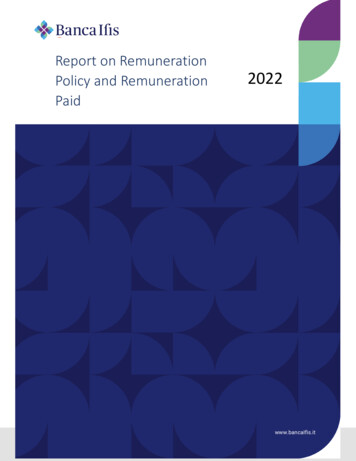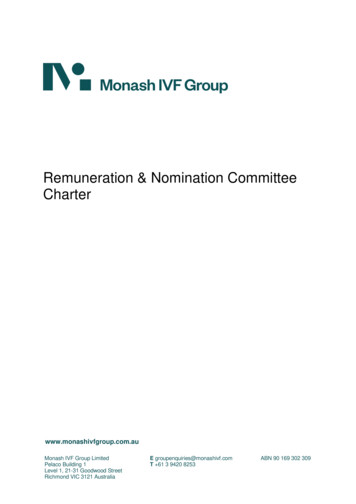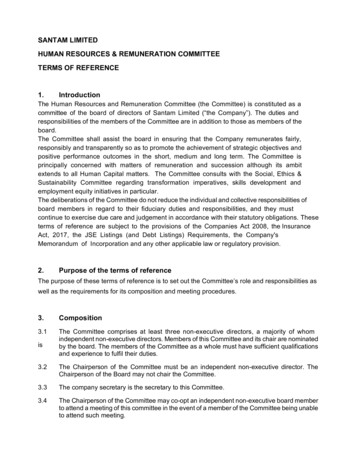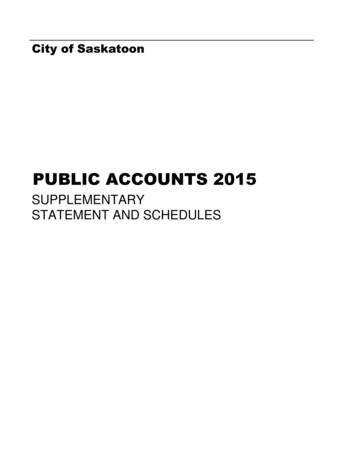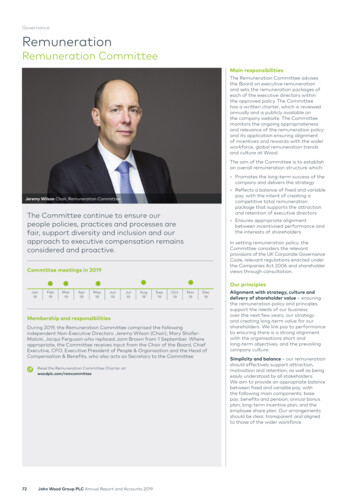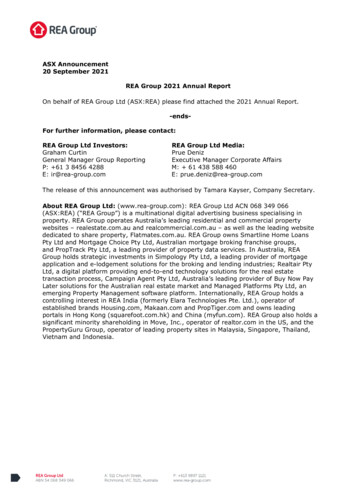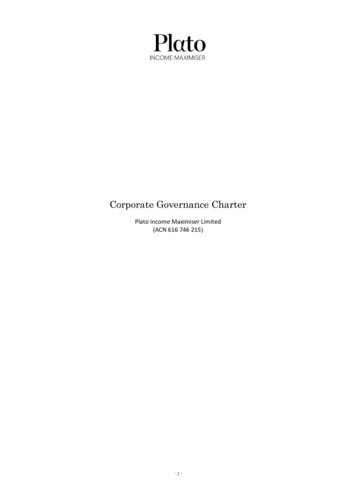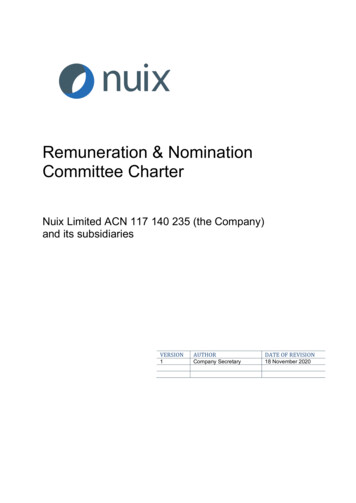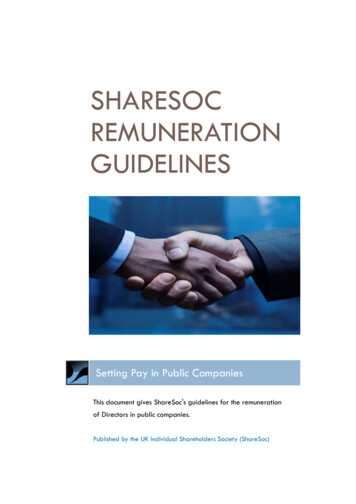
Transcription
SHARESOCREMUNERATIONGUIDELINESSetting Pay in Public CompaniesThis document gives ShareSoc's guidelines for the remunerationof Directors in public companies.Published by the UK Individual Shareholders Society (ShareSoc)
ShareSoc Remuneration GuidelinesContentsForewordPage 2Executive SummaryPage 4ObjectivesPage 6Larger CompaniesPage 7Smaller CompaniesPage 10PILLAR 1 - Pay for Performance LinkagePage 11PILLAR 2 - The Level of RemunerationPage 12PILLAR 3 - Management Share OwnershipPage 16PILLAR 4 - Clarity and TransparencyPage 17PILLAR 5 - Good Governance and Business PracticesPage 18ConclusionPage 19Appendix - Remuneration DisclosuresPage 20GlossaryPage 24Page 1
ShareSoc Remuneration GuidelinesShareSoc RemunerationGuidelinesS E T T I N G P AY I N P U B L I C C O M P A N I E SFOREWORDThere has been substantial criticism of Director remuneration in publiccompanies of late. Many consider current awards grossly excessive, with thepay of Directors continuing to rise disproportionally to that of other staff andofficers. This tendency has been exacerbated by ever more complex payschemes featuring multiple bonuses and long term incentive schemes. Suchcomplexity can make it very difficult for shareholders to evaluateremuneration policies and to form a view as to whether payouts arereasonable.This document attempts to provide simple guidance on what a suitable payscheme should look like, particularly for smaller companies.The Members of ShareSoc (the UK Individual Shareholder Society) have aright to expect fair and equitable returns on their investments. They look forthe Directors to be reasonably, but not excessively, compensated for goodperformance and for their interests to be aligned with all the stakeholders inthe business. Trust and respect in business stems from Directors doing “theright things” and we believe that companies that perform well and have agood Director Remuneration policy will gain the respect and admiration of agrowing shareholder base.There is a general consensus that pay levels need to be restrained, butexisting mechanisms are not effective in doing so. Hence, ShareSoc hasdeveloped its own guidelines.We hope this guidance will prove to be of use not just for investors whenreviewing the remuneration of companies in which they have invested, butalso the directors of such companies when they are considering paystructures.Mark NorthwayChairmanMay 2016Page 2
ShareSoc Remuneration GuidelinesPage intentionally blank.Page 3
ShareSoc Remuneration GuidelinesExecutive SummaryThis document sets out ShareSoc's Guidelines for the remuneration of publiccompany directors.ShareSoc proposes different guidance for large and small companies, due tothe significant differences in the way remuneration is approached between thetwo.For larger companies, ShareSoc believes and recommends: Current levels of FTSE100 CEO pay are excessive. An appropriatelevel of compensation should be less than half of the amountscurrently being awarded. FTSE 100 CEOs’ maximum bonus should be 100% of salary(currently 200% is typical) and LTIP maximum normal annual awardshould be 100% of salary (currently 300% is typical). It may benecessary to offer more to externally recruited CEOs, in their first year. Remuneration creep needs to be reversed. Remuneration has tripledover the last 18 years, but the FTSE 100 share index has barelyincreased at all. To strengthen the executive board’s focus on the company’s long termperformance, share options should be a central element of theremuneration package, with the requirement that a meaningful portionof share incentives must be held throughout tenure.Manifest has agreed to allow ShareSoc to publish Manifest reports on itswebsite. These reports contain a detailed analysis of remuneration for mainmarket and larger AIM companies.For smaller companies (those with market cap less than 200 million),ShareSoc has developed specific recommendations: Salaries should not be more than the median of comparable sizedcompanies. For a CEO, we give specific guidance on what isreasonable. Bonuses. Fast growth companies should conserve cash. ShareSocprefers such companies to reward management through equityincentives. Once a company is profitable, a bonus may be appropriate.For a profitable company, the maximum bonus for a CEO should be100% of salary: a lower limit is often sufficient. Share Incentives: Share Options are a simple and clear incentive formanagers of small companies. The exercise price of share optionsshould be set at not less than the market price at the date of grant.Page 4
ShareSoc Remuneration Guidelines LTIPs and nil cost options, with complex performanceconditions are unnecessary for small companies and should notbe used. Value Creation Schemes should also not be used.Dilution should be less than 10% of equity over a 10-year period. This can befront ended, but some should be reserved for top ups and new recruits.A typical structure might be 2% for the CEO with another 3% for top team, sothe CEO and top team have 5%, but how this is shared out will depend on theroles and skills of the top team.There should be clear disclosure of remuneration in the annual report andshareholders should asked to vote on remuneration and share schemes.Page 5
ShareSoc Remuneration GuidelinesObjectivesShareSoc’s objective in promulgating these guidelines is to improveremuneration practices and to better align them with the interests ofshareholders. In particular, we aim to help companies avoid bad remunerationpractices and we look to provide a framework for good remuneration practice.ShareSoc believes there should be an equitable balance between directors’personal interests and those of the company they direct and its shareholders,as a matter of good governance. We want remuneration committees to betruly independent and to balance those interests in a fair and reasonablemanner.We also hope that these Remuneration Guidelines will enable ShareSocMembers to monitor and engage with the Directors of the companies in whichthey invest and to critically assess their remuneration policies and practices.ShareSoc's 5 Pillars of Good RemunerationThese Remuneration Guidelines have been developed in line with the followingfive principles:1. Performance Linkage: There should be a demonstrable linkagebetween historic pay and performance (shown by 6 year TSR graph,Single Figure Remuneration and % of maximum pay-outs from bonusand options/long term variable pay).2. Pay Level: Remuneration (salary, equity incentives, bonus andbenefits) should be demonstrably reasonable. This is measured interms of:i) amount.ii) % share of revenue, profits, cash flow, market cap, increasein market cap, dilution, etc.3. Share Ownership: Management should own and retain significantamounts of shares in their company.4. Clarity and Transparency. Remuneration policies should be clear andeasily understandable by investors.5. Good Remuneration Governance – independence, consultation,disclosure, voting and sound business practices.Page 6
ShareSoc Remuneration GuidelinesLarger CompaniesShareSoc has adopted different guidance for large and small companies, dueto the significant differences in the way remuneration is approached incompanies of different size and stage of development.Large companies are complex in terms of the scope and scale of theirbusiness operations. Their remuneration arrangements tend to be complex.They attract significant media attention. The remuneration numbers involvedare very large in terms of absolute amount, even though they may representonly a small percentage of turnover, profits or market capitalisation.There already exists a plethora of guidelines for large companies. The UKCorporate Governance Code provides best practice guidance for remunerationfor large companies. In addition, there are best practice guidelines from theInvestment Association (formerly the ABI) and the Pensions and Life SavingsAssociation (formerly the NAPF), Manifest, PIRC, the IOD, the QCA and manyfund managers including Hermes, Fidelity, F&C and many others.There would be little value in ShareSoc developing its own remunerationguidelines for large companies, as this would add even more confusion to thecurrent situation.ShareSoc has therefore reached agreement with Manifest to publishManifest’s reports on the our website. These reports contain adetailed analysis of remuneration in main market and larger AIMcompanies. The availability of these reports is a very significant benefit tofully paid up ShareSoc Members.ShareSoc members are also invited to write their own reports on investeecompanies and to make comments on the Remuneration Forum of theShareSoc Members website (again accessible only by Full uneration-forumThe 5 Pillars provide a good framework to analyse the remuneration in largecompanies, and these are complemented by the following additional ShareSocopinions: FTSE100 CEO pay is currently too high. Examples include WPP ( 70min 2015, Reckitt 23m in 2015, BP a 20% increase to 14 millionagainst the backdrop of a 4.6 billion loss in 2015). ShareSoc hascommented publicly on these and other cases.Page 7
ShareSoc Remuneration Guidelines The FTSE 100 CEO pay policy model is also too high, with bonuses inmany cases at 200% of salary and LTIPs at 300% of salary. Thesepercentages should be less than half current levels. Remuneration creep needs to be reversed. CEO remuneration hastripled over the last 18 years, while over the same period the FTSE100 share index has barely increased at all. Remuneration creepoccurs in a number of ways and each of these should be identified andexposed, For example: –oSalary increases at greater than the rate for other employees.Over time modest-looking salary increases can compound tosignificantly increase remuneration, particularly as otherawards tend to be set as a percentage of salary. There is astrong case for fixing the salary of the chief executive when heor she is appointed with no further increases; incentive pay willreward performance.oIncreases in bonus maximum opportunity, or payment level fortarget performance, or setting easier targets, which mean thathigher bonuses are paid than would have been in previousyears for the same level of performance. Adopting additionalperformance measures which are easier to achieve than theprevious measures, is another way of increasing the likelypayout. The use of the balanced scorecard approach is oftenassociated with soft targets and vigilance by shareholders isnecessary in such cases.oIncreases in the size of long-term incentive awards or settingtargets which are easier to achieve than was the previous case.Adopting additional long-term performance measures which areeasier to achieve than the previous measures, thus increasingthe likely payout.oMaking awards of long-term incentives at the same level ofsalary following a substantial decrease in the share price (e.g.Anglo American), which can produce windfall payouts formerely recovering to the previous level of share price.oUse of pension arrangements which hide the increase of valueor potential value to the executive (e.g. BP where the chiefexecutive has a pension based on salary and bonus).oMaking large acquisitions that increase the volatility of futureresults. For example, the probability of the share price doublingor halving over three years may increase from 10% to 30% asa result of a large acquisition. The odds of achieving an EPSgoal or ROCE goal may similarly improve.Page 8
ShareSoc Remuneration GuidelinesThe effect on remuneration is to increase the potential value ofthe future remuneration plans, although the effect onshareholders is minimal and the alignment with shareholders issignificantly reduced. Complexity in remuneration design is unhelpful. Simplification shouldbe the goal where possible. However, there is a danger of furtherremuneration creep arising from over-simplification. Soft targets should be avoided. Remuneration Committees should bechallenged to justify such targets. ShareSoc members are wellpositioned to challenge the board at AGMs. Generous use of discretion and interpretation of incentive scheme rulesso as to boost incentive scheme payouts should similarly bechallenged. The lack of disclosure of incentive targets, so that investors cannot seeif the targets are easy or stretching, is unacceptable. The use of “thetargets are commercially sensitive” excuse is in most cases selfserving. If a measure is a KPI and if it is worth rewarding the CEO forthe achievement of that KPI, the company must be able to explainwhat the target is and show that the threshold, target and maximumpayout opportunities are stretching. Share options should be emphasised in remuneration packages, alongwith also strict share-holding requirements, so that a meaningfulportion of stock incentives must be held to the end of a Director’stenure or beyond. The Remuneration Committee chair must be capable of standing up tothe demands/requests of the executive board members. Historically,institutional investors have not provided the NEDs with adequatesupport. Shareholders should vote against the re-election of thedirector who is the Remuneration Committee chair where concernsexist, providing real pressure to resist excessive demands from theexecutive directors. Lastly and possibly most importantly, the appointment of a new CEO isa critical opportunity to control remuneration. To be effective, the CEOmust work with a team of executives. Excessive remuneration to a newCEO is divisive and should be avoided. For most FTSE 100 companies,there are plenty of capable people able to do a good CEO job, so it isunnecessary to pay excessively to hire an external recruit. However, if,for example, it is necessary to provide a 5 million per annum packageto hire a new CEO and a package that will pay out 25 million over fiveyears and double that if the share price doubles, then the companyshould say so in simple language and justify it.Page 9
ShareSoc Remuneration GuidelinesSmaller CompaniesShareSoc has developed its Remuneration Guidelines specifically forcompanies with less than 200 million market cap. Small companies are lesscomplex and their remuneration should reflect this. The ShareSoc guidelinesare consistent with the principles of the QCA Remuneration Committee Guide(which is designed for Small and Mid-Size Quoted Companies), but ShareSocprovides specific guidance on levels of salary, incentives and the percentageof equity dilution.Our focus is on the CEO’s remuneration (or Executive Chairman or highestpaid director as the case may be). In nearly all cases with smaller companies,if the CEO’s remuneration package and awards are reasonable, then this willbe reflected acrss the board and management structure.The ShareSoc methodology looks at each of the 5 Pillars of GoodRemuneration, but does not give weightings to each of them. We believe thatin some cases that a particularly bad approach for any one of the pillars couldresult in a bad overall assessment for a company. We do not want companiesto be able to trade off a good assessment under one pillar with a poorperformance under another.Page 10
ShareSoc Remuneration GuidelinesPILLAR1 - Pay for Performance Linkage1.1PrinciplesShareSoc expects that pay should be linked to performance and shareholdersshould have a say on pay (see Pillar 5). Poor performance should not berewarded with high pay, nor should mediocre performance be rewarded withhigh pay. High pay may be acceptable when performance is very good.Pay should be linked to performance over a period of years. Companiesshould show the relationship of performance and pay using the format in theAppendix, together with a commentary to explaining both the linkage and thereasons for lack of a relationship. Doing this will help build trust betweeninvestors and the company.1.2AnalysisAnalysis focuses on the share price or TSR (TSR share price change plusdividends) graph (at least 6 years or since IPO), comparing the company’sTSR with that of a generic index and a sector, plus an analysis of KPIs andbonus and LTIP pay-outs as a % of maximum, salary and the single totalfigure of remuneration.Page 11
ShareSoc Remuneration GuidelinesPILLAR 2 - The Level of Remuneration2.1Remuneration PrinciplesSalary (and benefits) should be reasonable. Most incentives should be equitybased. Companies that pay less than average in cash may provide moregenerous equity incentives. Bonuses should not normally be paid unless thecompany is profitable.The remuneration of the CEO sets the tone for the rest of the organisation. Itshould not be excessive. It should be demonstrably reasonable against peerbenchmarks, measured in terms of:i) amount.ii) % share of revenue, profits, cash flow, market cap, increase inmarket cap, dilution, etc.The CEO remuneration should not be overly large in comparison to the rest ofthe organisation. Excessive pay differentials are likely to be demotivational,unless there are special reasons which can be clearly explained to employeesand shareholders.2.2SalariesThe CEO’s salary should be set on appointment and thereafter shouldnormally only be increased in line with the average increase awarded toemployees. A CEO is paid to perform and when he/she does, an increase insalary is not necessary, as he/she will be rewarded through incentives.Salaries should ideally not be more than the median (of other companies) andcertainly not excessively more. ShareSoc’s Recommended Maximum Salariesare shown in the graphs below. Salaries increase with the size and complexityof the company. The turnover or market cap is a good proxy for complexity.For a CEO, the following graphs show what is acceptable to ShareSoc. Forexample, ShareSoc believe that a 50m turnover company should pay theirCEO a salary of not more than 245k pa.Recommended Maximum CEO Salary in by Turnover mTurnover mSalary 50245,000100300,000250366,000Recommended Maximum Salary in by Turnover 50,000‐050100150Company Turnover millionPage 12200250
ShareSoc Remuneration GuidelinesShareSoc recognises that some sectors have significant revenues but minimalprofits; this should reduce the level of what is a reasonable salary. Conversely,high margin businesses may warrant higher salaries. The ShareSoc guidancepermits flexibility to allow for the type of company.Recommended Maximum CEO Salary in by Market Cap mAn alternative way to benchmark salary is to look at the market cap of thecompany. This is notoriously unreliable as share prices and market caps go upand down by considerable amounts and very rarely do salaries go in tandem withsuch movements. Some (weak) remuneration committees ratchet up salarieswhen market cap increases, but do not even consider adjustments the other way.With this proviso, the following table and graph show the ShareSoc MaximumRecommended Salary for companies with market caps at the following levels:Market cap mSalary 244,000250333,000Recommended Maximum Salary in by market cap ��050100150200250Company Market Cap in million2.3Equity/Share IncentivesShare Options are a simple and clear incentive for managers of small companies.The exercise price of share options should not be set at less than the marketprice at the date of grant. LTIPs (see Glossary) and nil cost options, with complexperformance conditions are unnecessary for small companies and should not beused. Value Creation Schemes (see Glossary) should not be used.Dilution should be less than 10% of equity over a 10 year period. This can befront ended, but some should be reserved for top ups and new recruits.A typical structure might be 2% for the CEO with another 3% for the top team,so the CEO and top team have 5%, but how this is shared out will depend on theroles and skills of the top team.Typically, there should be another 3% for other managers and all employees;with another 2% in reserve for new recruits. (Note leavers’ awards will usuallyfall back into the pool, so there will be more than 2% available in practice.)Page 13
ShareSoc Remuneration GuidelinesPotential gains from this approach are sufficient to incentivise management, seetable below:Share price increasemultiple xManagement share option gains from 10% dilution5x3x2x 4m 2m 1m 10m 12m 6m 3m 30mMarket cap at start 40m 20m 10m 100mFor example, if the share price increases fivefold (5x), and the company was 30million market cap when the options were granted, then the market cap will growto 150 million and if the management (including directors) had been awardedoptions over 10% of the shares, their collective option gains would be 12million.We believe that a fast growth company should be targeting at least doubling itsreturns to shareholders (i.e. share price plus dividends) over the planning period.The smaller the company, the larger will be the expectation of growth. Modellingthe potential gains, using illustrative changes in share prices, identifies thepotential rewards from equity incentives: the company and its shareholders canthen decide if the potential rewards are appropriate.Equity incentives encourage management to build up and retain significantstakes in their company. Shareholders should view with concern companieswhose management sell down their stakes.Share Options should not be exercisable for at least three years after grant.(ShareSoc prefers 50% of options to vest after 3 years and 50% after 5 years.This creates a longer term focus and reduces the possibility that the CEO willrequest a large top up incentive after 3 years have elapsed.)EMI (Enterprise Management Incentives - see Glossary) are highly tax effectivefor management and for companies and should be implemented whenever thecompany meets the qualifying conditions.Sharing Success with employeesEMI options can provide a share in success when awarded in small amounts toall/most employees.Awards of shares to all employees under a SIP (Share Incentive Plan - seeGlossary) can be very tax effective. Reserving 5% of profits for all employeeprofit sharing distributed via a SIP can be one way to help avoid divisiveness andencourage a culture of all sharing in success together.2.4BonusesStart up companies should conserve cash, as should fast growth companies.ShareSoc prefers such companies to reward management through equityincentives. Once a company is profitable, a bonus may be appropriate.Page 14
ShareSoc Remuneration GuidelinesFor a profitable company, the CEO’s maximum bonus should be 100% of salary:a lower limit is often sufficient. Payment of half of the bonus in cash and half inshares (e.g. as nil cost options) that must be held for at least three years isencouraged. In general, the higher the bonus, the more that should be paid inshares.The performance measures that determine bonus should link to the key strategicmilestones and KPIs shown in the strategic report in the annual report.In exceptional circumstances, a bonus may be paid to a CEO of a loss makingcompany. In such cases, the maximum bonus should be 50% of salary and itmay be better to pay this in shares in order to conserve cash. A bonus may beappropriate in some pre-revenue/pre-profit companies, where it is linked tomeasurable and stretching milestones along the path to commerciality.Companies should have a clear policy on how profits are split between the bonuspool, dividends and reinvestment in the business and explain this to itsshareholders.2.5Adjustments to incentive targetsWhere the incentive scheme rules permit, any adjustments to incentive targets(e.g. as a result of issuing new shares, raising or paying off debt, acquisitions ordisposals, decisions re whether items are exceptional or trading) must be fair toboth shareholders and management. Softening of targets so as to increaseincentive scheme payments is an unacceptable practice.2.6Reloading/RepricingReloading or re-pricing can potentially occur when a company’s share price hasreduced. If the share price reduction is a result of management’s performance,then ShareSoc will (normally) expect some of the management to have left.Under such circumstances, ShareSoc would agree with the need to re-incentivisethe rest of the team. However, it may not be necessary to award as much equityas before, as there should be scope to grow the market capitalisationsubstantially and increases in shareholder value of 5 times or even 10 times maybe possible in such circumstances. Careful modelling of potential outcomes isrequired and will justify what the appropriate rate of dilution should be in suchcircumstances.2.7Fair rewards through the cycleSome business sectors are notoriously cyclical. A company that invests at the topof the cycle may find its share price subsequently declines by 50% or even 90%.Issuing management with new incentives at the bottom of the cycle, which payout for failing to get back to the original situation is highly dubious. Shareholdersshould look for fair rewards through the business cycle.Page 15
ShareSoc Remuneration GuidelinesPILLAR 3 - Management Share Ownership3.1Share Ownership PrinciplesManagement should build up and retain significant stakes in their businesses.Stakes should be both personally material and represent a reasonablepercentage of outstanding shares.ShareSoc would like the major part of management’s rewards to be linked toincreases in the share price over the long term.Management should not normally sell shares in their companies. If they do,they should explain clearly the reasons why they are doing so.3.2 AnalysisShareholders should review the share ownership of the CEO over the pastseveral years, e.g.:Year20102011201220132014Number of shares re price at year end 0.05 0.03 0.04 0.07 0.08 0.10Value of shares owned 5,000 3,000 6,000 10,500 16,000 20,000Vested options - number0200,000300,000500,000750,0001,000,000 2,000 4,500 20,000 37,500 60,000Unvested options ins tooptions 6,000 2,000 0 4,000 6,000 10,000Total of shares owned plusgains to date on options 11,000 7,000 10,500 34,500 59,500 90,000Shares soldnumber000000000000Gains on vested optionsdateoninunvestedtheyear-Shares sold in the year -value Page 162015
ShareSoc Remuneration GuidelinesPILLAR 4 - Clarity and Transparency4.1 PrinciplesThe annual report should show clearly how much the CEO and other directorshave been paid and how much they may be paid, potentially.The explanation should be in plain English.Complexity should be avoided. If remuneration cannot be simply explained,shareholders should view this negatively.The full requirements of the Remuneration Disclosures required for mainmarket companies are unnecessary for smaller companies. (Our view is thatwhile those disclosures add additional data, they also add to the complexity ofunderstanding the key remuneration issues)The recommended minimum remuneration disclosures for companies wantingto build trust with their investors are provided in the Appendix.Cross-referring to other year’s remuneration reports and to circulars toshareholders may be “transparent” but is not helpful to shareholders. Allrelevant information necessary to explain remuneration to shareholdersshould be in one place in the remuneration report. It should not be necessaryto follow a complex trail to find out what is really happening and companiesthat try to hide remuneration details in this way will be exposed and criticised.4.2 AnalysisThere are no specific analyses on this pillar, but each remuneration reportshould be assessed against the above principles.Page 17
ShareSoc Remuneration GuidelinesPILLAR 5 - Good Governance and Business PracticesPrinciplesA remuneration committee should make remuneration decisions, withIndependent Non-Executive Directors in the majority.Companies should consult with key shareholders (to include a representativenumber of individual shareholders) about potentially contentiousremuneration issues.Where concerns are raised by shareholders about a company’s remunerationarrangements, the company should engage with its key shareholders aboutthe issues raised and explain how it intends to address the concerns.Companies should table an advisory vote on their remuneration report at theAGM and invite shareholders to approve any new long-term incentive schemes(including their performance targets, unless clearly commercially sensitive).Companies must be concerned about their culture, values and ethics. Itmatters how business results are achieved, as well as what is achieved.AnalysisThere is no specific analysis on this pillar, but each remuneration reportshould be assessed against the above principles.Page 18
ShareSoc Remuneration GuidelinesConclusionShareSoc’s objective is to improve companies’ remuneration practices, so thatShareSoc Members and other shareholders receive fair and equitableinvestment returns.The Guidelines in this document provide a framework for good remunerationpractice, and can help companies avoid bad remuneration practices.These Remuneration Guidelines will also enable ShareSoc Members to monitorand engage with the Directors of the companies in which they invest and tocritically assess their remuneration policies and practices.If you have any comments on the contents of this document please sendthem to ShareSoc using the Contact Information on the final page.Page 19
ShareSoc Remuneration GuidelinesAPPENDIX - Remuneration DisclosuresSuggested minimum remuneration disclosure for AIM/ISDXcompanies wishing to build trust with their investorsStatement from the Rem Com Chair. Example:The Remuneration Committee aims to set remuneration packages thatmotivate and reward executives to deliver lo
1. Performance Linkage: There should be a demonstrable linkage between historic pay and performance (shown by 6 year TSR graph, Single Figure Remuneration and % of maximum pay-outs from bonus and options/long term variable pay). 2. Pay Level: Remuneration (salary, equity incentives, bonus and benefits) should be demonstrably reasonable.
